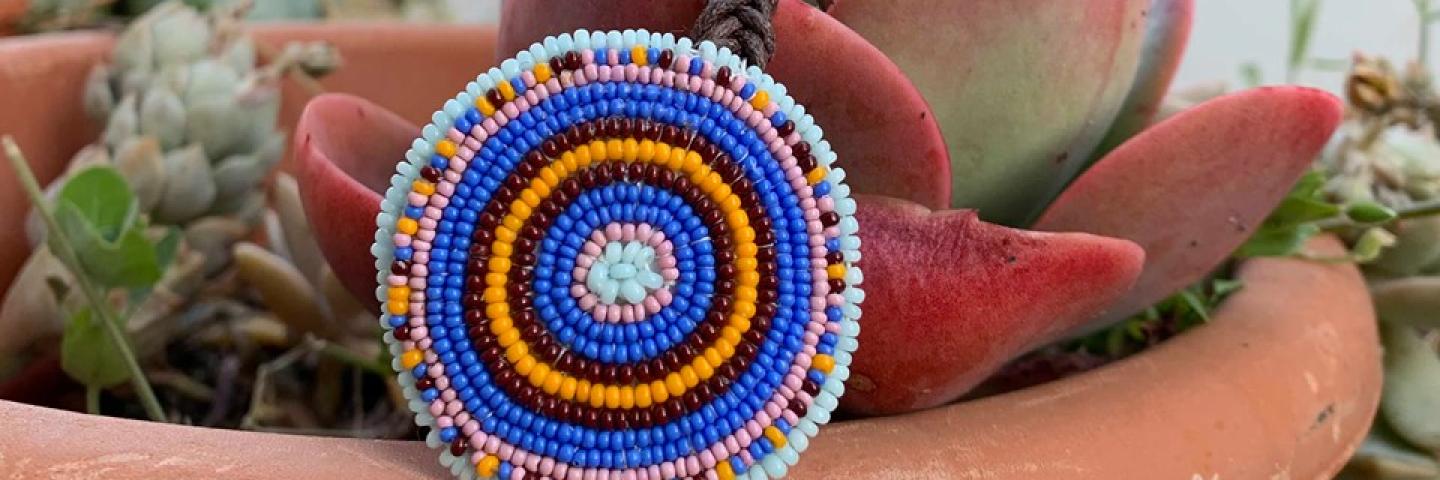 | Traditional Skill/Art Craft: Cayuse/ Nez Perce Applique Beadwork Years Awarded: 2018 Contact Information: Phone: (541)300-5148 Email: msohappy@wstribes.org
|
ARTIST BIOGRAPHY
My maternal family has been residents of Oregon from time immemorial. My young indigenous name is Ip-as-ship-ap-la-chon-my. I was named after the fourth wife of Tu-eka-kas (Old Chief Joseph of the Wallowa Band of Nez Perce). My mother, Jean Halfmoon was a Cayuse and Nez Perce descendant of which my adult name is from, Ishkepin meaning to "give everything away".
I am a tribal member of the Confederated Tribes of Warm Springs, by virtue of my father, Fred Kalama's heritage. Lilly Pitt, my father's paternal grandmother, descended from "slaves" of the Wasco Band prior to the 1855 Treaty. Charles Pitt (Lilly's father), a Pitt River Paiute, had been captured by the Modoc. He became an interpreter and assimilated into the Wasco Band by marrying Julia Pollush a tribal member.
After the Paiute War, the Pitt family was identified with the Northern Paiute people eventually becoming members of the Seekseequa District of the Warm Springs Indian Reservation. Another paternal ancestry demonstrates the beauty of my family heritage. My father's paternal grandfather, Peter Kalama, was half Hawaiian and half Nisqually. My father's mother was Karuk from northern California. Many of my elders have served on tribal councils, participated in ceremonies, are veterans of tribal and non-tribal wars, and are recognized leaders in their communities.
APPRENTICE BIOGRAPHY - Kaliyah Michelle Iverson 2018
Kaliyah Michelle Iverson is a member of the Confederated Tribes of the Warm Springs and a descendant of Nisqually, Pitt River, Nez Perce, Cayuse, Karuk, and Hawaiian people from her mother’s side, and of African American heritage from her father’s side. She is 17 years old and began participating in the museum at Warm Springs workshops where she learned loom beading, tule mats, wapas yarn baskets, and painting. She learned from her grand uncle how to loom bead and participates in cultural activities such as root digging, huckleberry picking, fishing, Powwows, and Washut religious ceremonies, and dances as a “Fancy Dancer”. She is learning how to create beadwork; the project includes making a beaded barrette and completing the yoke using the “lazy stitch”. She hopes to continue her beadwork and create her own beaded regalia and get help making her own “Fancy Dance” dress. Marjorie is her maternal grandmother and will pass on their family history and culture through this project.
Q+A WITH THE MENTOR ARTIST
Describe your traditional art.
Body
The cultural tradition I practice is applique beadwork in the Plateau Style. The range of the beadwork to be taught for TAAP will start with small jewelry items such as hairpins and conclude with beadwork on a “Fancy Dance” regalia yoke.
Generally, beadworking is a home-based practice due to the volume of material that is required to complete one item, and the considerable time it takes to complete a project. I work year-round on a multitude of small and larger projects. Applique beadwork is part of everyday life, and it is also important for ceremonies, rituals, and special occasions.
Beadwork is a sign of respect to our elders, as it is a show of one’s desire to respect the family of which one had been raised and to continue a skill handed down from one generation to the next. There are family designs, tribal designs, and individual designs of which one can be identified. I have developed a well-recognized style to my own beadwork, while still using traditional techniques. The techniques used by my elders instill pride in my work.
How did you come to learn this tradition?
Body
I learned this tradition from Jean Halfmoon, my mother, in our home starting in the 1970s, when I was a junior in High School. My mother taught me the beadwork of my maternal great-grandmother Julia Whitewolf and her sister Elizabeth. Their beadwork dated from the early 1900s and items handed down to them from their elders.
My work is based on the work of generations of artists from my cultural heritage. I am connected to this tradition through my Cayuse ancestry from the upper Columbia River and Nez Perce, and it is following this heritage that I find inspiration for my beadwork designs, colors, and detail. These tribal groups are well known for specific geometric and floral designs, and as part of this cultural heritage, I have learned to use buckskin dresses, vests, horse regalia, purses, gloves, belts, moccasins, baby boards, hats, and many other art objects.
Why is this cultural tradition important to your community?
Body
Beadwork is a remarkable talent which has been replicated by other cultures and has lost teachers to time. In our history, tribal communities have been vulnerable, and our life expectancy rates caused teacher/ student numbers to fall. Today, beadwork is a “luxury.” Those who have the time and materials required are limited. Our tribal community will benefit from more experienced beadworkers, to reassure the perpetuation of our culture. The beading tradition is a “sign” to a way of life that can be practiced and celebrated in the manner it was designed, a traditional manner of “wearing your finest for the creator” during good times. Beadwork is a sign of everything good about our community.
Experience/Honors
Body
Museum at Warm Spring-Tribal Member Art Exhibit:
2016-Honorable Mention for Elk Tooth dress
2014-Honorable Mention for Beaded Wallet
2013-Honorable Mention for Beaded Handbag
2009-Honorable Mention for Girls Fancy Dance Regalia
2008-Judge’s Choice Award for Plateau Style Beaded Baby Board
2007-Honorable Mention for Bridal Set Women’s beaded hair clip and beaded fan/Men’s beaded pipe and beaded feather
Burke Museum On-site Visiting Researcher 2016-2017
High Desert Museum 2010 Demonstration of collection of completed beaded work.
Visit OFN's Culture Keepers Roster to learn more about the artist.
Traditional Arts Apprenticeship Program
More OFN programs
OFN main page
